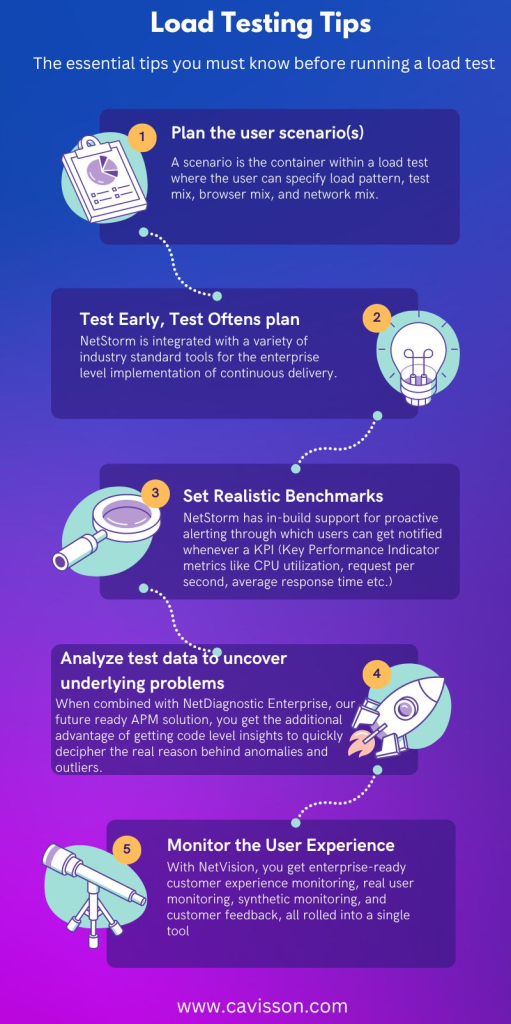
A load test is a technique used to measure the response of a system under various load conditions. It assists in identifying the maximum capacity of an application and also any bottlenecks and finds out which element is degrading.
Load testing is a crucial component of performance testing that is gaining immense importance in today’s digital-driven world. Performance testing gauges whether a web application can handle high volumes and patterns of traffic before it goes live. It is a practice in which the performance of the system is tested under peak traffic conditions for web applications and APIs. By simulating the concurrent access of multiple users to an application, testers create a model of the expected usage of the application.
We’ve compiled 5 integral load testing tips that will ensure a comprehensive and wide-ranging coverage from a performance perspective of your business-critical applications
Tip 1: Plan the user scenario(s)
The primary place to start is by finding out the user scenarios that you want to test. For reference, a user scenario which can also be referred to as a load script is a program that describes every action that a virtual user in a load test should perform. Let’s say you’re running an e-commerce website where users need to log in using a username and password. That’s a vital part of your flow, and you need to add those HTTP requests in your usage scenario. Load test scenarios consist of Web performance tests or unit tests. A scenario is a container within a load test where the user can specify load pattern, test mix, browser mix, and network mix. Scenarios are important because they provide flexibility to users in configuring test characteristics that allow for the simulation of complex, realistic workloads.
For any type of testing, the most essential step is a well-defined test plan. And when performing non-functional testing and especially load test(s) then the importance of this test plan is automatically doubled. For example, for websites with high user traffic, the most important challenge for the QA teams is to see if the website is ready for peak traffic via a load test.
Replicate Real-World Scenarios with NetStorm: The Advanced Scenario Modeling feature in NetStorm enables you to faithfully replicate production scenarios to test your application’s performance with real-world load and use cases by using the following functionalities:
- Goal-based scenario design with NetStorm where test scenarios can be designed using causal criteria (e.g. number of concurrent users) or symptomatically (e.g. load the system until 95 percentile of response times are less than 300 ms or the server CPU is less than 80% busy).
- Web user behavior simulation includes a mechanism to simulate page reloads and click-aways by users among a host of other actionable insights that creates your test cases more realistic to understand how your application behaves in real-world scenarios. Some of the features of this functionality that you can utilize are:
- User arrivals rate modeling & production logs replay creates a load model that is a faithful replication of production use cases with minimal memory use.
- Simulating user behavior e.g. hitting the browser refresh button on the slow download & Click-aways on the slow response (Premature session closure by end-users).
- Click-Away’s on the slow response (Premature session closure by end-users).
- Internet-True(™) WAN simulation: NetStorm’s base operating system is designed from the ground up to provide a true simulation of WAN behavior, as experienced by actual web and mobile application users. With a networking stack built for this purpose, NetStorm can simulate packet delay, packet loss, packet reordering, and packet duplication. NetStorm’s state of art network simulation makes it possible to mimic mobile users with 3G/4G network speed or web users located in San Francisco using a web application hosted in Chicago.
Tip 2: Test Early, Test Often
Whether your team is adopting Agile, DevOps, or any other practice, it’s essential to test early and test often. Performance testing is generally isolated and starts when a development project is over. However, in the last few years increasing the amount of feedback throughout your software development life cycle has proved immensely valuable in finding and fixing issues rapidly. Emphasize making performance testing, and load testing, in particular, a part of your agile, continuous integration, and automation practices.
Continuous Delivery is a design practice used in software development to automate and improve the software delivery process. Using techniques like automated testing, continuous integration, and continuous deployment, the software can be developed to a high standard and easily packaged and deployed to test environments, allowing for rapid, reliable, and repeatable delivery of enhancements and bug fixes to customers, with a low degree of risk and minimal manual overhead.
How NetStorm enables you to test early and test often?
NetStorm is integrated with a variety of industry-standard tools for the enterprise-level implementation of continuous delivery. While test execution occurs on NetStorm, monitoring is done by a machine agent deployed on your performance environment. Additionally, NetDiagnostics, our total observability APM solution can be utilized for carrying out detailed drill downs and identifying the proverbial needle in the haystack by giving you insights across your entire tech stack.
A small example of NetStorm enabling you to test early & test often is how we integrate with Jenkins to trigger a test suite that is created on NetStorm and in parallel, capture detailed data on application/infrastructure/network performance. You can configure SLAs on critical metrics like request rate, error rate, and latency among others. On the basis of these SLAs, the performance tests are either categorized as Passed (If SLAs are met) or Failed (If SLAs are not met), giving you a head-start in terms of identifying performance issues with your latest releases and fixing them before any business impact is seen.
NetStorm automates the execution of tests and displays CI/CD reports based on configured rules. Not only that, you can generate and share reports via our powerful reporting module with a one-time setup to make sure that all stakeholders are sent such reports and can act quickly to mitigate issues.
Tip 3: Set Realistic Benchmarks
Top notch application performance makes no business sense if that performance does not match up to your competitors’ products. A careful study is needed to chalk out the list of transactions to be compared across products so that like-for-like comparison is possible. Identify practical & realistic tests that can reflect a reality, whether that means selecting devices, browsers, a number of users, etc. And, load tests can’t start from zero. In the real world, it’s doubtful that the systems you’re looking to update will not be running under a load already.
Netstorm, with its proprietary InternetTrue(™) algorithm, enables enterprises to faithfully recreate production scenarios across different levels i.e. network simulation, mimicking production load patterns where multiple phases like ramp up, ramp down, stabilize can help you in starting with a certain number of users and scaling them up subsequently to reflect real life scenarios.
With the help of these features, enterprises can comprehensively test their applications with a production like environment to be assured that when the said application is deployed for its users, they can rest easy knowing that a thorough, end to end load testing has been carried out.
Tip 4: Analyze test data to uncover underlying problems
After running your load tests, the first step is to identify any problem areas & take the next best steps to enhance performance for that component. This means correlating performance bottlenecks with the code to isolate the root cause of the issue. Commonly this can be difficult if you’re using a traditional testing tool because it requires ‘translating’ the test results into metrics you can hold to share with your development team to dig deeper into the core code starting the issue.
How NetStorm can help uncover underlying problems?
The root cause can be determined by pattern matching correlating spikes with other graphs showing the tendency to vary together. Pattern matching is used to identify all those application and system metrics that contain a similar pattern. Users can correlate two or more graphs from our dashboard for analysis and quickly identify the impact of a single spike across the entire application ecosystem.
When combined with NetDiagnostic Enterprise, our future-ready APM solution, you get the additional advantage of getting code-level insights to quickly decipher the real reason behind anomalies and outliers. Imagine running performance tests with real-world use cases and then getting actionable information to diagnose issues. Sounds too good to be true? With Cavisson, it’s an everyday reality.
Tip 5 – Monitor the User Experience
Load testing makes sure that your site or an app won’t crash, but you also need to make sure your users have a pleasing experience. As a part of the DevOps and CI approach, we suggest you also test your web browsers and operating systems. In this way, you can discover if any of the changes you made didn’t affect performance – but ended up affecting the all-important user experience.
With NetVision, you get enterprise-ready customer experience monitoring, real user monitoring, synthetic monitoring, and customer feedback, all rolled into a single tool:
NetVision is a powerful and comprehensive solution to ensure exceptional online customer experience via monitoring responsiveness and ease of interactions with online assets. NetVision offers great insight into customer responsiveness and the ability to record and replay entire user sessions along with interactions to determine any anomalies within the application that may affect user experience or revenue. With the additional advantage of fetching code-level & log level details, implementing user experience monitoring with your performance testing methodology leaves no stone unturned in your quest for excellence in CX.

Types of Load Tests
Now that we have had a look at some of the essential load test tips, it’s time to understand the different types of load tests that you can conduct to comprehensively test your application’s performance. Let’s briefly explore some of the critical load test types:
- Failover testing– It is a technique that validates if a system can allocate extra resources and back up all the information and operations when a system fails abruptly due to some reason. This test determines the ability of a system to handle critical failures and handle extra servers.
- Load Test- Load testing refers to the practice of modeling the expected usage of a software program by reproducing multiple users accessing the program together.
- Spike Testing- It is a type of performance testing in which an application experiences a sudden and major increase or decrease in load. The goal of spike testing is to determine the behavior of a software application when it receives a major difference in traffic.
- Longevity Testing- To validate system or product stability and serviceability features over a longer period against appropriate load and stress conditions with real-time traffic and applications. To reduce the occurrence of defects surfacing at the Customer site.
The most important part of load testing isn’t the execution itself; it’s what you do with the results. We hope these tips aid you in your effort in devising a comprehensive test coverage to make your applications stable and successful.
Contact us today to see how our experience management platform gives you the ability to test & monitor your entire application ecosystem, across pre-production & production environments from a single product and leverage our decades old expertise to provide exceptional customer experience and stay ahead of the curve.

